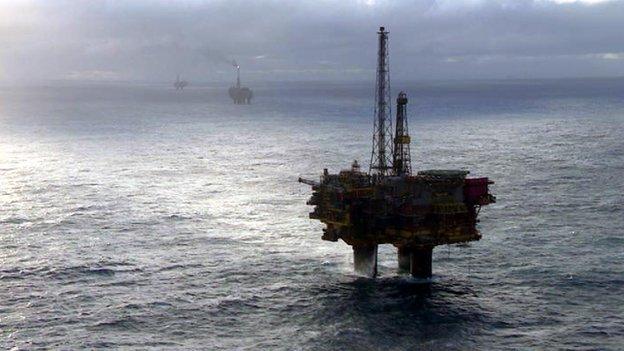Gearing up for the big lift in the North Sea
- Published
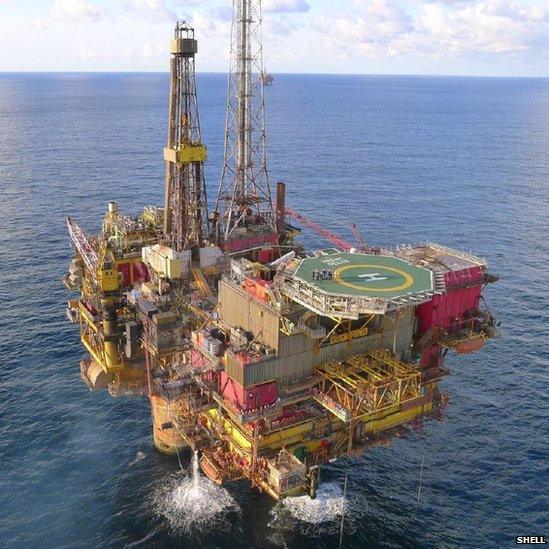
The Delta platform topside includes the helipad and the main accommodation block
How do you go about removing a massive piece of infrastructure from a hostile environment like the North Sea?
Oil giant Shell has come up with one answer which could be put to the test next year - using a mega-ship to remove the topside of an oil platform in a single lift.
Measuring 300m from the seabed to its highest point, the Brent Delta platform stands as tall as the Eiffel Tower.
The structure, one of four located in the Brent field, is located 115 miles out to sea off Shetland. It has reached the end of its production life after 35 years.
At its peak in 1982, the Brent field produced more than half a million barrels of oil per day. Production that year would have met the annual energy needs of around half of all UK homes.
Plans have been drawn up by operator Shell to decommission Delta, and a new giant Korean-built ship has been lined up to take on the first major challenge.
At 382m long - the length of five jumbo jets - Pioneering Spirit has been tasked with removing the Delta's 24,000-tonne topside. That's the part of the platform which houses the accommodation block, helipad and other operational areas.

According to a Shell inventory, the 44m-tall topside includes 10 tonnes of asbestos (used for insulation and gaskets), 899 tonnes of paint, 31 tonnes of batteries, six tonnes of cotton for bedding and 3,446 fluorescent lighting tubes.
The oil firm hopes Pioneering Spirit - originally called Pieter Schelte - will prove a game-changer by successfully removing the main structure in one go.
In preparation for the monumental task, Pioneering Spirit is currently in Rotterdam being fitted out with sixteen 65-metre long beams which will be used for the lift.
If Shell's decommissioning plan is cleared by UK authorities, the ship will head out next year to Brent, where she will position herself around the Delta platform.
She will then position hydraulic clamps at strong points under the structure before pumping water out of her ballast tank to lift the topside.
The lifting process is expected to take only a few seconds.

How to remove a 24,000 tonne topside
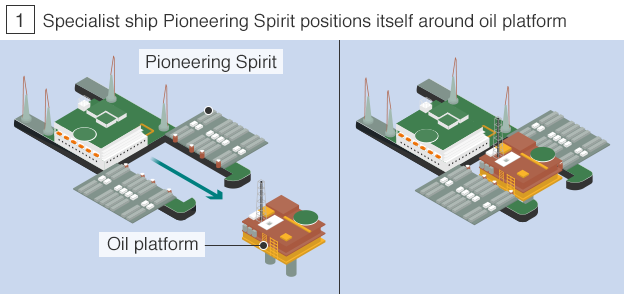
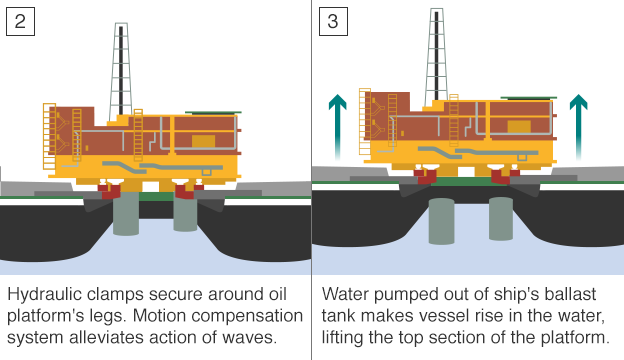

Swiss owner Allseas says Pioneering Spirit has been designed to lift as much as 48,000 tonnes in one go.
But the ship faces another huge challenge - how to remain steady in hostile North Sea waters during the crucial lifting process.
To tackle that, its lift systems have been fitted out with an active motion compensation system.
This animation shows how the Brent Delta oil platform will be lifted off its legs
Allseas maintains that the ship can carry out a lift in waves of up to 3.5m high.
'Hostile environments'
On its website, the company says: "Analysis has shown that in hostile environments such as the North Sea, a motion compensation system is essential on a single-lift vessel to eliminate impact forces on large topsides.
"In the absence of such a system, local damage can occur even when the wave height is small and vessel motions are very limited."
Shell considered two other options for the Delta topside before choosing the single lift.
One was a process known as "piece small," which involves cutting the topside into small pieces - each weighing between 10kg and 100kg - and shipping them back to shore.
The second option, "reverse install," involves cutting and removing large sections or modules in the reverse order from which they were installed.
Shell argues that its single-lift proposals will reduce time, costs and environmental risks associated with the decommissioning process.
'Innovative solutions'
Brent decommissioning project director Alistair Hope said: "The award of the contract to Allseas to use the Pioneering Spirit vessel demonstrates Shell's commitment to finding safe, innovative solutions.
"It is the first vessel ever built with the ability to remove topsides of this size and scale in one lift."
If all goes according to plan, Pioneering Spirit will then ship the topside structure to a special yard in Hartlepool for dismantling.
Rig recycling
The Brent platform contains
19,781
tonnes of carbon steel
-
3,446 fluorescent lighting tubes
-
899 tonnes of paint on structure
-
20 cubic metres of firefighting foam
-
10 tonnes of asbestos
Shell is aiming to have 97% of the material recycled.
Should it successfully carry out the giant lift, Pioneering Spirit could be kept busy in the Brent field for the best part of a decade.
Allseas also has a contract from Shell to remove the topsides of two of the other three platforms in the field - Bravo and Alpha (along with Alpha's steel jacket) - subject to consultation and UK government approval.
It has an option to do the same with the fourth platform, Charlie.
Together the four topsides have a combined weight of more than 100,000 tonnes.
Shell has yet to put forward its decommissioning proposals for the rest of Brent - one of the largest fields in the North Sea, with more than 140 wells and 28 pipelines.
Three of the platforms (Bravo, Charlie and Delta) have giant concrete "legs" which support the topsides above the surface of the sea.
Known as gravity base structures, they feature clusters of huge concrete oil storage tanks or "cells" at their base.
The cells contain large quantities of gravel ballast, used to anchor the structure to the seabed.
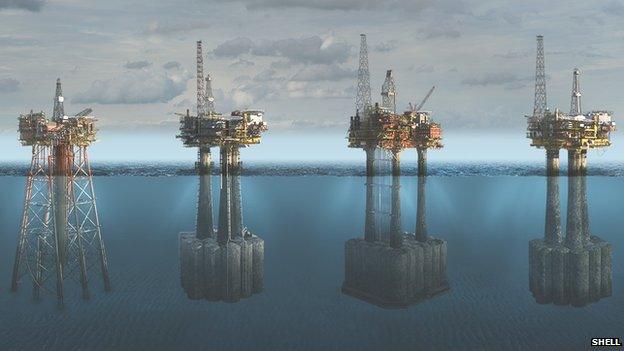
There are four platforms in the Brent field - Alpha, Bravo, Charlie and Delta
How Shell intends to handle that tricky part of the decommissioning process has yet to be unveiled.
However, the company says its plans will be submitted when it is confident they are "safe, technically achievable, environmentally sound and financially responsible".
'Not without risk'
Environmental group WWF Scotland is giving qualified support for the planned Delta lift.
Director Lang Banks told BBC Scotland: "It certainly is not without risk, but on balance lifting the topside in one go is probably the safest method for staff and will be the least damaging for the environment.
"However, the biggest challenge is yet to come with how to deal with what lies beneath the waves. The thousands of tonnes of steel, concrete and drilling muds all require to be dealt with.
"The industry pushed the boundaries of science and engineering to access North Sea oil and gas.
"Having made massive profits over the last few decades, it's only right that it should push those limits once again to clean up their potentially hazardous legacy and protect the marine environment.
"Given the enormous size of the rigs and the iconic nature of the Brent field, this decommissioning will be watched closely and should therefore be aiming to set the highest possible benchmarks for the rest of the industry to follow."
In the meantime, Pioneering Spirit's first big project later this year will be the removal of the smaller Yme platform 100km off the shores of Norway on behalf of Talisman Energy.
Many observers will be keeping a close eye on how the ship fares with that major technical challenge.
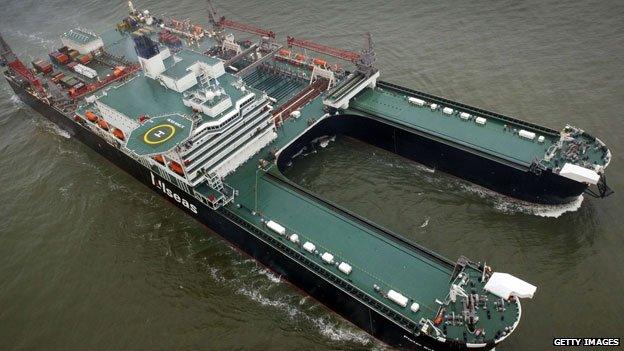
The specialist Pioneering Spirit is the world's largest platform decommissioning vessel
- Published28 May 2015
